Comprehensive Analysis of Elias: A Pediatric Case Study and Care Plan
VerifiedAdded on 2020/03/04
|15
|3970
|58
Report
AI Summary
This report presents a comprehensive case study of a three-year-old male child named Elias, who exhibits delayed motor development, irritability, and malaise, with vitamin D deficiency and impetigo. The report details assessment strategies, including the use of the HINT tool to evaluate motor development and communication skills, as well as assessing for DMDD or SMD. Medical management options discussed include AAC approaches, motor-based interventions, electromagnetic brain stimulation, RIT, and pharmacotherapy for irritability and vitamin D supplementation, along with topical and oral antibiotics for impetigo. Nursing interventions focus on addressing risk factors, providing education, and creating a supportive environment. The care plan emphasizes improving motor development, managing irritability, and addressing vitamin D deficiency and impetigo through nutritional management, sleep schedules, play activities, and family-centered approaches. The goal is to improve the child's motor skills, behavior, and overall well-being within the community environment.
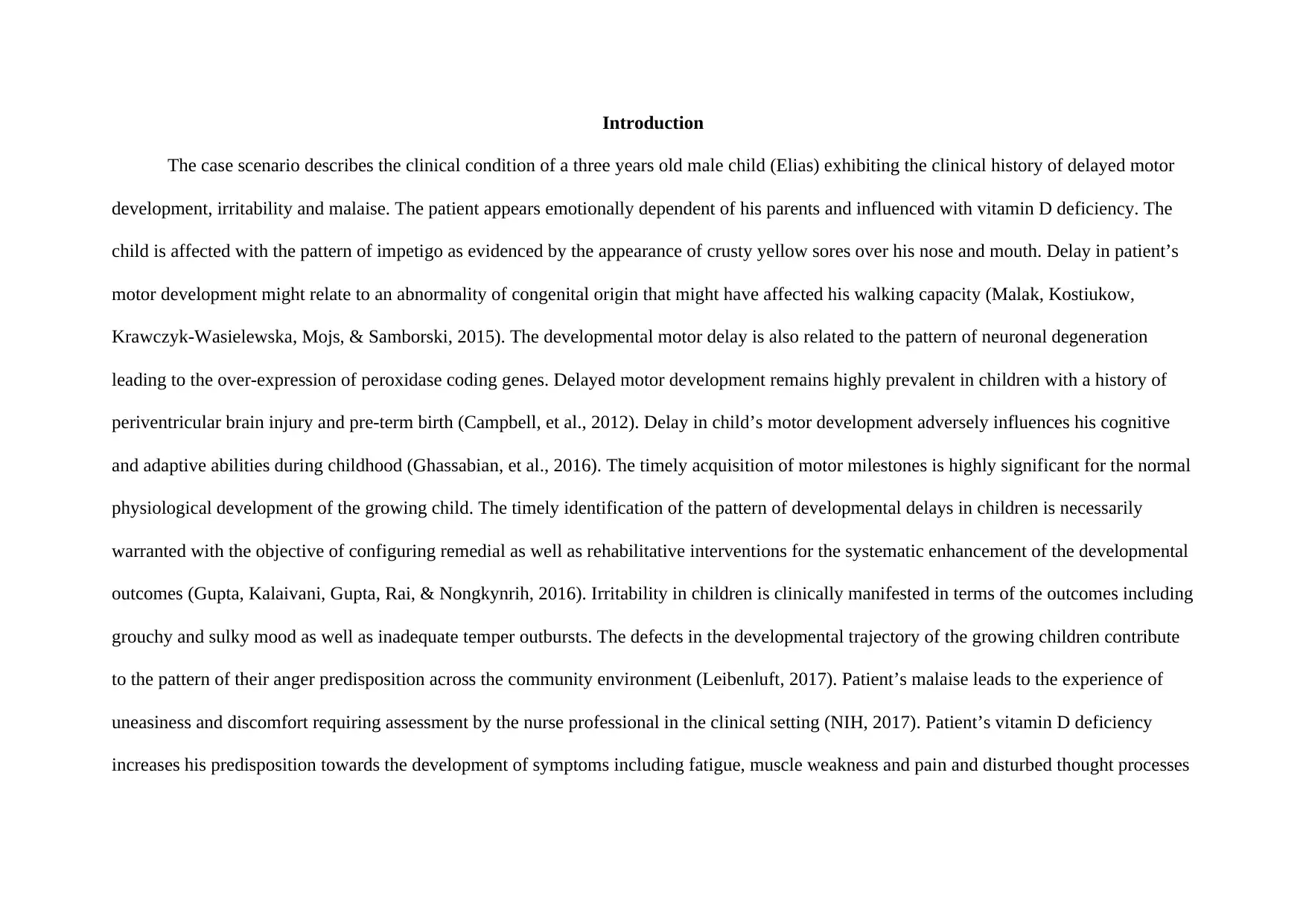
Introduction
The case scenario describes the clinical condition of a three years old male child (Elias) exhibiting the clinical history of delayed motor
development, irritability and malaise. The patient appears emotionally dependent of his parents and influenced with vitamin D deficiency. The
child is affected with the pattern of impetigo as evidenced by the appearance of crusty yellow sores over his nose and mouth. Delay in patient’s
motor development might relate to an abnormality of congenital origin that might have affected his walking capacity (Malak, Kostiukow,
Krawczyk-Wasielewska, Mojs, & Samborski, 2015). The developmental motor delay is also related to the pattern of neuronal degeneration
leading to the over-expression of peroxidase coding genes. Delayed motor development remains highly prevalent in children with a history of
periventricular brain injury and pre-term birth (Campbell, et al., 2012). Delay in child’s motor development adversely influences his cognitive
and adaptive abilities during childhood (Ghassabian, et al., 2016). The timely acquisition of motor milestones is highly significant for the normal
physiological development of the growing child. The timely identification of the pattern of developmental delays in children is necessarily
warranted with the objective of configuring remedial as well as rehabilitative interventions for the systematic enhancement of the developmental
outcomes (Gupta, Kalaivani, Gupta, Rai, & Nongkynrih, 2016). Irritability in children is clinically manifested in terms of the outcomes including
grouchy and sulky mood as well as inadequate temper outbursts. The defects in the developmental trajectory of the growing children contribute
to the pattern of their anger predisposition across the community environment (Leibenluft, 2017). Patient’s malaise leads to the experience of
uneasiness and discomfort requiring assessment by the nurse professional in the clinical setting (NIH, 2017). Patient’s vitamin D deficiency
increases his predisposition towards the development of symptoms including fatigue, muscle weakness and pain and disturbed thought processes
The case scenario describes the clinical condition of a three years old male child (Elias) exhibiting the clinical history of delayed motor
development, irritability and malaise. The patient appears emotionally dependent of his parents and influenced with vitamin D deficiency. The
child is affected with the pattern of impetigo as evidenced by the appearance of crusty yellow sores over his nose and mouth. Delay in patient’s
motor development might relate to an abnormality of congenital origin that might have affected his walking capacity (Malak, Kostiukow,
Krawczyk-Wasielewska, Mojs, & Samborski, 2015). The developmental motor delay is also related to the pattern of neuronal degeneration
leading to the over-expression of peroxidase coding genes. Delayed motor development remains highly prevalent in children with a history of
periventricular brain injury and pre-term birth (Campbell, et al., 2012). Delay in child’s motor development adversely influences his cognitive
and adaptive abilities during childhood (Ghassabian, et al., 2016). The timely acquisition of motor milestones is highly significant for the normal
physiological development of the growing child. The timely identification of the pattern of developmental delays in children is necessarily
warranted with the objective of configuring remedial as well as rehabilitative interventions for the systematic enhancement of the developmental
outcomes (Gupta, Kalaivani, Gupta, Rai, & Nongkynrih, 2016). Irritability in children is clinically manifested in terms of the outcomes including
grouchy and sulky mood as well as inadequate temper outbursts. The defects in the developmental trajectory of the growing children contribute
to the pattern of their anger predisposition across the community environment (Leibenluft, 2017). Patient’s malaise leads to the experience of
uneasiness and discomfort requiring assessment by the nurse professional in the clinical setting (NIH, 2017). Patient’s vitamin D deficiency
increases his predisposition towards the development of symptoms including fatigue, muscle weakness and pain and disturbed thought processes
Paraphrase This Document
Need a fresh take? Get an instant paraphrase of this document with our AI Paraphraser
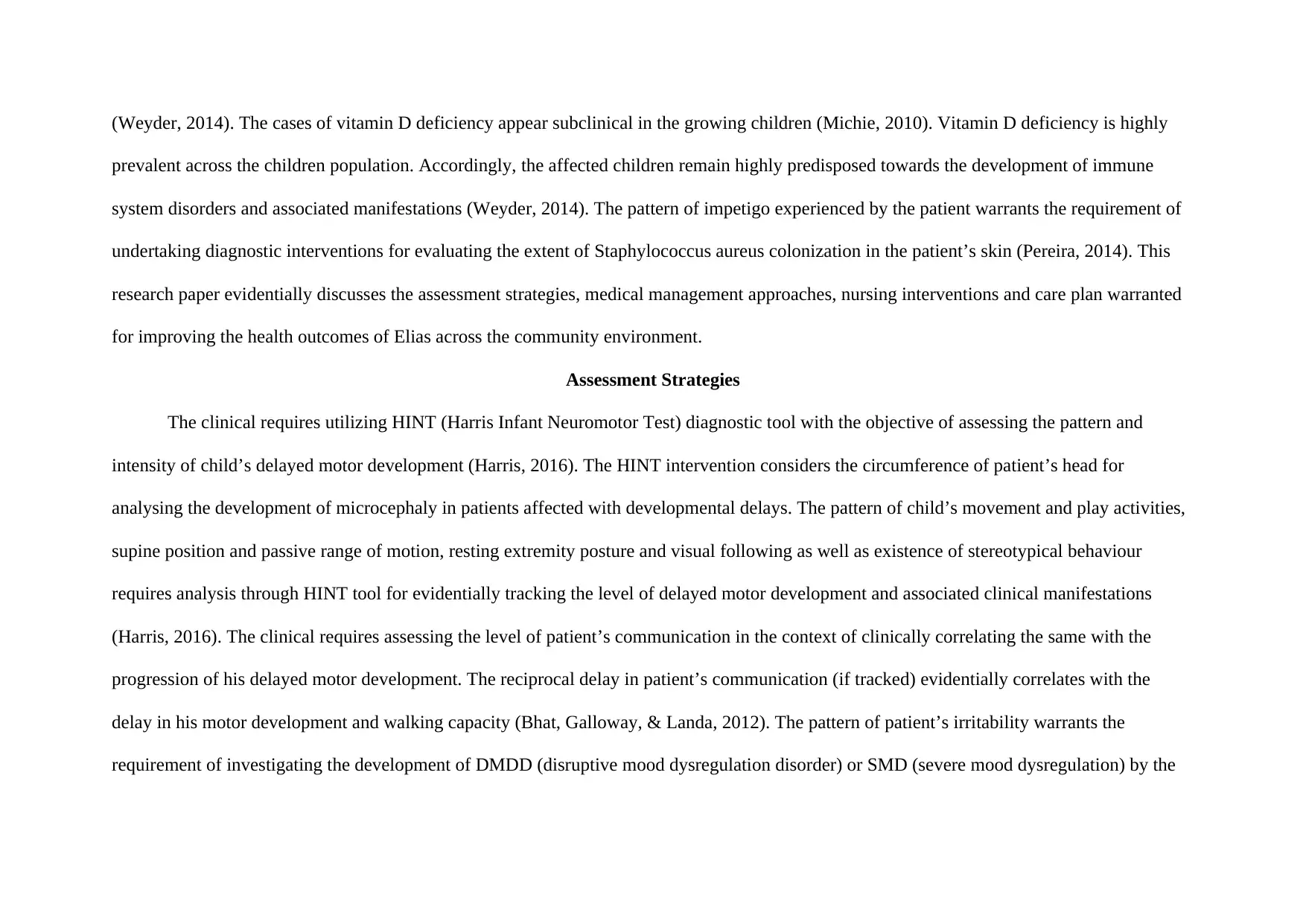
(Weyder, 2014). The cases of vitamin D deficiency appear subclinical in the growing children (Michie, 2010). Vitamin D deficiency is highly
prevalent across the children population. Accordingly, the affected children remain highly predisposed towards the development of immune
system disorders and associated manifestations (Weyder, 2014). The pattern of impetigo experienced by the patient warrants the requirement of
undertaking diagnostic interventions for evaluating the extent of Staphylococcus aureus colonization in the patient’s skin (Pereira, 2014). This
research paper evidentially discusses the assessment strategies, medical management approaches, nursing interventions and care plan warranted
for improving the health outcomes of Elias across the community environment.
Assessment Strategies
The clinical requires utilizing HINT (Harris Infant Neuromotor Test) diagnostic tool with the objective of assessing the pattern and
intensity of child’s delayed motor development (Harris, 2016). The HINT intervention considers the circumference of patient’s head for
analysing the development of microcephaly in patients affected with developmental delays. The pattern of child’s movement and play activities,
supine position and passive range of motion, resting extremity posture and visual following as well as existence of stereotypical behaviour
requires analysis through HINT tool for evidentially tracking the level of delayed motor development and associated clinical manifestations
(Harris, 2016). The clinical requires assessing the level of patient’s communication in the context of clinically correlating the same with the
progression of his delayed motor development. The reciprocal delay in patient’s communication (if tracked) evidentially correlates with the
delay in his motor development and walking capacity (Bhat, Galloway, & Landa, 2012). The pattern of patient’s irritability warrants the
requirement of investigating the development of DMDD (disruptive mood dysregulation disorder) or SMD (severe mood dysregulation) by the
prevalent across the children population. Accordingly, the affected children remain highly predisposed towards the development of immune
system disorders and associated manifestations (Weyder, 2014). The pattern of impetigo experienced by the patient warrants the requirement of
undertaking diagnostic interventions for evaluating the extent of Staphylococcus aureus colonization in the patient’s skin (Pereira, 2014). This
research paper evidentially discusses the assessment strategies, medical management approaches, nursing interventions and care plan warranted
for improving the health outcomes of Elias across the community environment.
Assessment Strategies
The clinical requires utilizing HINT (Harris Infant Neuromotor Test) diagnostic tool with the objective of assessing the pattern and
intensity of child’s delayed motor development (Harris, 2016). The HINT intervention considers the circumference of patient’s head for
analysing the development of microcephaly in patients affected with developmental delays. The pattern of child’s movement and play activities,
supine position and passive range of motion, resting extremity posture and visual following as well as existence of stereotypical behaviour
requires analysis through HINT tool for evidentially tracking the level of delayed motor development and associated clinical manifestations
(Harris, 2016). The clinical requires assessing the level of patient’s communication in the context of clinically correlating the same with the
progression of his delayed motor development. The reciprocal delay in patient’s communication (if tracked) evidentially correlates with the
delay in his motor development and walking capacity (Bhat, Galloway, & Landa, 2012). The pattern of patient’s irritability warrants the
requirement of investigating the development of DMDD (disruptive mood dysregulation disorder) or SMD (severe mood dysregulation) by the
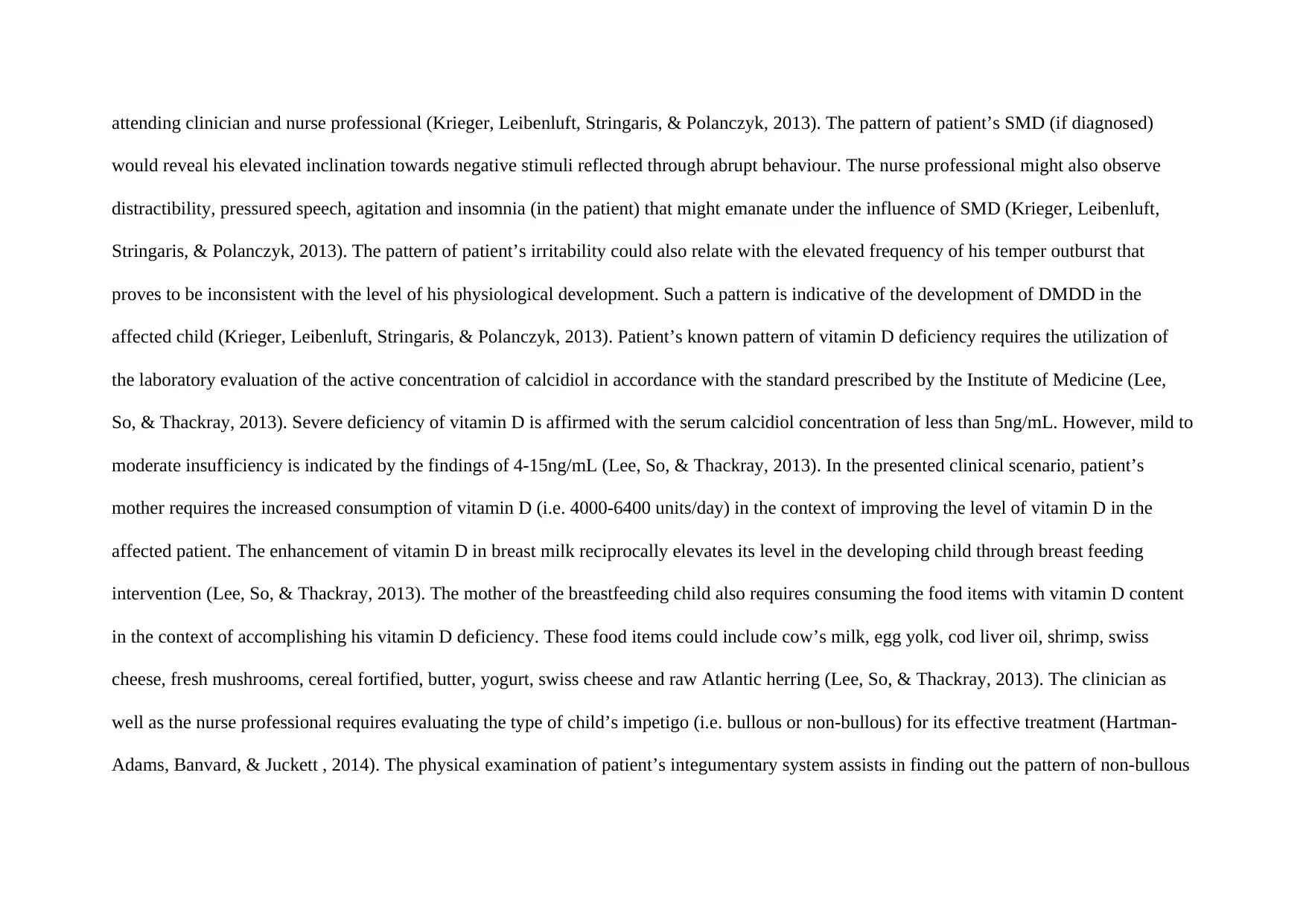
attending clinician and nurse professional (Krieger, Leibenluft, Stringaris, & Polanczyk, 2013). The pattern of patient’s SMD (if diagnosed)
would reveal his elevated inclination towards negative stimuli reflected through abrupt behaviour. The nurse professional might also observe
distractibility, pressured speech, agitation and insomnia (in the patient) that might emanate under the influence of SMD (Krieger, Leibenluft,
Stringaris, & Polanczyk, 2013). The pattern of patient’s irritability could also relate with the elevated frequency of his temper outburst that
proves to be inconsistent with the level of his physiological development. Such a pattern is indicative of the development of DMDD in the
affected child (Krieger, Leibenluft, Stringaris, & Polanczyk, 2013). Patient’s known pattern of vitamin D deficiency requires the utilization of
the laboratory evaluation of the active concentration of calcidiol in accordance with the standard prescribed by the Institute of Medicine (Lee,
So, & Thackray, 2013). Severe deficiency of vitamin D is affirmed with the serum calcidiol concentration of less than 5ng/mL. However, mild to
moderate insufficiency is indicated by the findings of 4-15ng/mL (Lee, So, & Thackray, 2013). In the presented clinical scenario, patient’s
mother requires the increased consumption of vitamin D (i.e. 4000-6400 units/day) in the context of improving the level of vitamin D in the
affected patient. The enhancement of vitamin D in breast milk reciprocally elevates its level in the developing child through breast feeding
intervention (Lee, So, & Thackray, 2013). The mother of the breastfeeding child also requires consuming the food items with vitamin D content
in the context of accomplishing his vitamin D deficiency. These food items could include cow’s milk, egg yolk, cod liver oil, shrimp, swiss
cheese, fresh mushrooms, cereal fortified, butter, yogurt, swiss cheese and raw Atlantic herring (Lee, So, & Thackray, 2013). The clinician as
well as the nurse professional requires evaluating the type of child’s impetigo (i.e. bullous or non-bullous) for its effective treatment (Hartman-
Adams, Banvard, & Juckett , 2014). The physical examination of patient’s integumentary system assists in finding out the pattern of non-bullous
would reveal his elevated inclination towards negative stimuli reflected through abrupt behaviour. The nurse professional might also observe
distractibility, pressured speech, agitation and insomnia (in the patient) that might emanate under the influence of SMD (Krieger, Leibenluft,
Stringaris, & Polanczyk, 2013). The pattern of patient’s irritability could also relate with the elevated frequency of his temper outburst that
proves to be inconsistent with the level of his physiological development. Such a pattern is indicative of the development of DMDD in the
affected child (Krieger, Leibenluft, Stringaris, & Polanczyk, 2013). Patient’s known pattern of vitamin D deficiency requires the utilization of
the laboratory evaluation of the active concentration of calcidiol in accordance with the standard prescribed by the Institute of Medicine (Lee,
So, & Thackray, 2013). Severe deficiency of vitamin D is affirmed with the serum calcidiol concentration of less than 5ng/mL. However, mild to
moderate insufficiency is indicated by the findings of 4-15ng/mL (Lee, So, & Thackray, 2013). In the presented clinical scenario, patient’s
mother requires the increased consumption of vitamin D (i.e. 4000-6400 units/day) in the context of improving the level of vitamin D in the
affected patient. The enhancement of vitamin D in breast milk reciprocally elevates its level in the developing child through breast feeding
intervention (Lee, So, & Thackray, 2013). The mother of the breastfeeding child also requires consuming the food items with vitamin D content
in the context of accomplishing his vitamin D deficiency. These food items could include cow’s milk, egg yolk, cod liver oil, shrimp, swiss
cheese, fresh mushrooms, cereal fortified, butter, yogurt, swiss cheese and raw Atlantic herring (Lee, So, & Thackray, 2013). The clinician as
well as the nurse professional requires evaluating the type of child’s impetigo (i.e. bullous or non-bullous) for its effective treatment (Hartman-
Adams, Banvard, & Juckett , 2014). The physical examination of patient’s integumentary system assists in finding out the pattern of non-bullous
⊘ This is a preview!⊘
Do you want full access?
Subscribe today to unlock all pages.

Trusted by 1+ million students worldwide
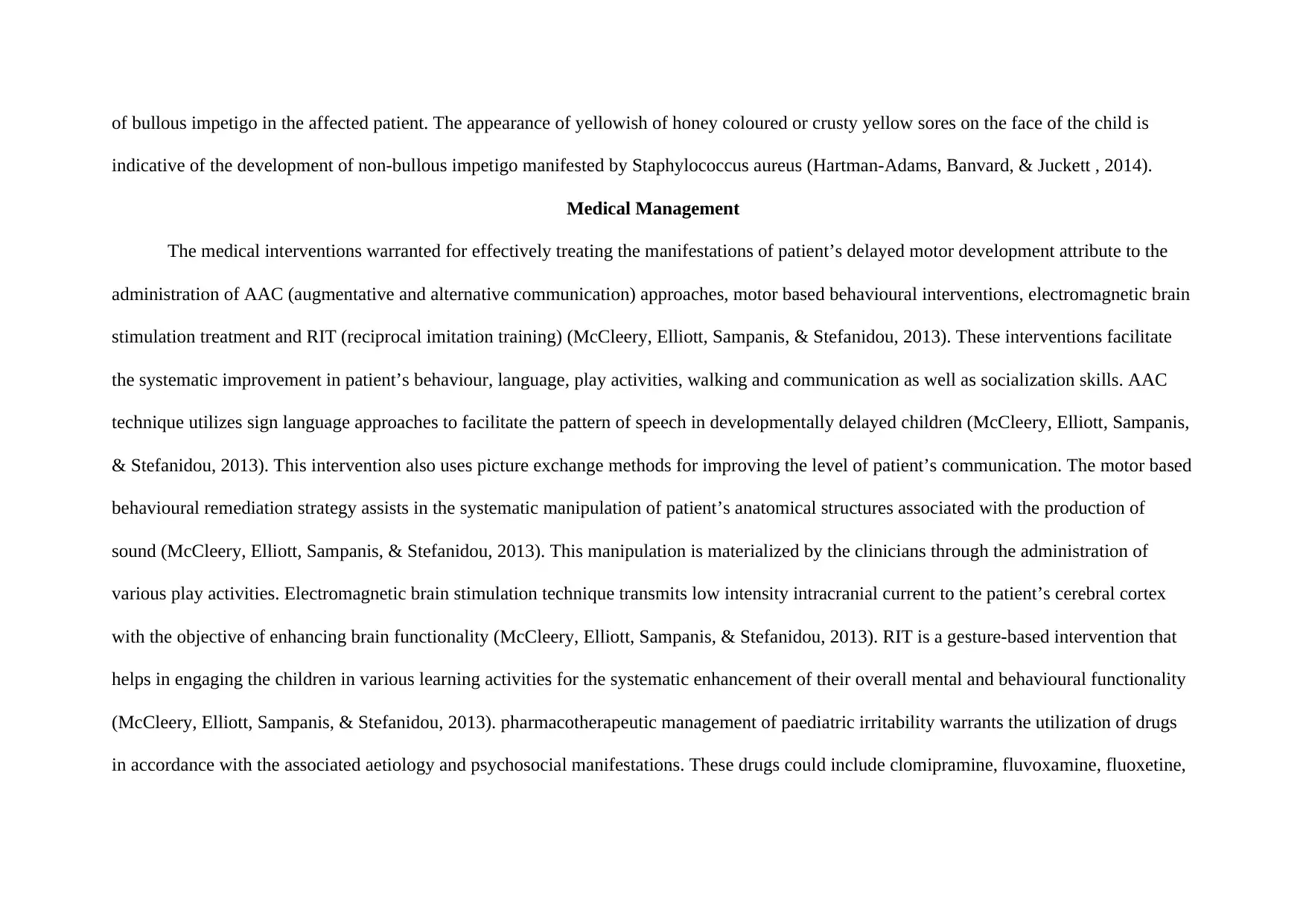
of bullous impetigo in the affected patient. The appearance of yellowish of honey coloured or crusty yellow sores on the face of the child is
indicative of the development of non-bullous impetigo manifested by Staphylococcus aureus (Hartman-Adams, Banvard, & Juckett , 2014).
Medical Management
The medical interventions warranted for effectively treating the manifestations of patient’s delayed motor development attribute to the
administration of AAC (augmentative and alternative communication) approaches, motor based behavioural interventions, electromagnetic brain
stimulation treatment and RIT (reciprocal imitation training) (McCleery, Elliott, Sampanis, & Stefanidou, 2013). These interventions facilitate
the systematic improvement in patient’s behaviour, language, play activities, walking and communication as well as socialization skills. AAC
technique utilizes sign language approaches to facilitate the pattern of speech in developmentally delayed children (McCleery, Elliott, Sampanis,
& Stefanidou, 2013). This intervention also uses picture exchange methods for improving the level of patient’s communication. The motor based
behavioural remediation strategy assists in the systematic manipulation of patient’s anatomical structures associated with the production of
sound (McCleery, Elliott, Sampanis, & Stefanidou, 2013). This manipulation is materialized by the clinicians through the administration of
various play activities. Electromagnetic brain stimulation technique transmits low intensity intracranial current to the patient’s cerebral cortex
with the objective of enhancing brain functionality (McCleery, Elliott, Sampanis, & Stefanidou, 2013). RIT is a gesture-based intervention that
helps in engaging the children in various learning activities for the systematic enhancement of their overall mental and behavioural functionality
(McCleery, Elliott, Sampanis, & Stefanidou, 2013). pharmacotherapeutic management of paediatric irritability warrants the utilization of drugs
in accordance with the associated aetiology and psychosocial manifestations. These drugs could include clomipramine, fluvoxamine, fluoxetine,
indicative of the development of non-bullous impetigo manifested by Staphylococcus aureus (Hartman-Adams, Banvard, & Juckett , 2014).
Medical Management
The medical interventions warranted for effectively treating the manifestations of patient’s delayed motor development attribute to the
administration of AAC (augmentative and alternative communication) approaches, motor based behavioural interventions, electromagnetic brain
stimulation treatment and RIT (reciprocal imitation training) (McCleery, Elliott, Sampanis, & Stefanidou, 2013). These interventions facilitate
the systematic improvement in patient’s behaviour, language, play activities, walking and communication as well as socialization skills. AAC
technique utilizes sign language approaches to facilitate the pattern of speech in developmentally delayed children (McCleery, Elliott, Sampanis,
& Stefanidou, 2013). This intervention also uses picture exchange methods for improving the level of patient’s communication. The motor based
behavioural remediation strategy assists in the systematic manipulation of patient’s anatomical structures associated with the production of
sound (McCleery, Elliott, Sampanis, & Stefanidou, 2013). This manipulation is materialized by the clinicians through the administration of
various play activities. Electromagnetic brain stimulation technique transmits low intensity intracranial current to the patient’s cerebral cortex
with the objective of enhancing brain functionality (McCleery, Elliott, Sampanis, & Stefanidou, 2013). RIT is a gesture-based intervention that
helps in engaging the children in various learning activities for the systematic enhancement of their overall mental and behavioural functionality
(McCleery, Elliott, Sampanis, & Stefanidou, 2013). pharmacotherapeutic management of paediatric irritability warrants the utilization of drugs
in accordance with the associated aetiology and psychosocial manifestations. These drugs could include clomipramine, fluvoxamine, fluoxetine,
Paraphrase This Document
Need a fresh take? Get an instant paraphrase of this document with our AI Paraphraser
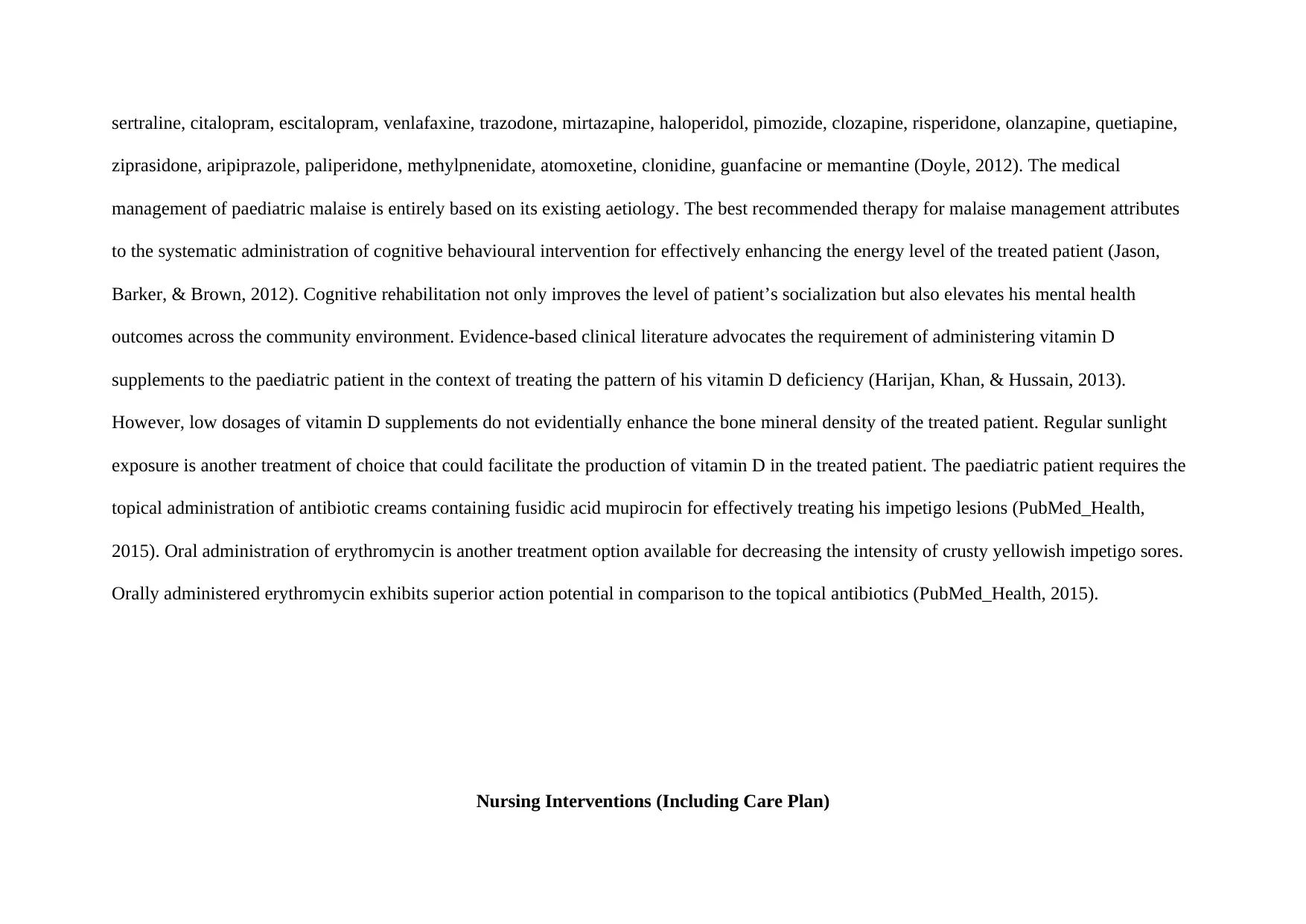
sertraline, citalopram, escitalopram, venlafaxine, trazodone, mirtazapine, haloperidol, pimozide, clozapine, risperidone, olanzapine, quetiapine,
ziprasidone, aripiprazole, paliperidone, methylpnenidate, atomoxetine, clonidine, guanfacine or memantine (Doyle, 2012). The medical
management of paediatric malaise is entirely based on its existing aetiology. The best recommended therapy for malaise management attributes
to the systematic administration of cognitive behavioural intervention for effectively enhancing the energy level of the treated patient (Jason,
Barker, & Brown, 2012). Cognitive rehabilitation not only improves the level of patient’s socialization but also elevates his mental health
outcomes across the community environment. Evidence-based clinical literature advocates the requirement of administering vitamin D
supplements to the paediatric patient in the context of treating the pattern of his vitamin D deficiency (Harijan, Khan, & Hussain, 2013).
However, low dosages of vitamin D supplements do not evidentially enhance the bone mineral density of the treated patient. Regular sunlight
exposure is another treatment of choice that could facilitate the production of vitamin D in the treated patient. The paediatric patient requires the
topical administration of antibiotic creams containing fusidic acid mupirocin for effectively treating his impetigo lesions (PubMed_Health,
2015). Oral administration of erythromycin is another treatment option available for decreasing the intensity of crusty yellowish impetigo sores.
Orally administered erythromycin exhibits superior action potential in comparison to the topical antibiotics (PubMed_Health, 2015).
Nursing Interventions (Including Care Plan)
ziprasidone, aripiprazole, paliperidone, methylpnenidate, atomoxetine, clonidine, guanfacine or memantine (Doyle, 2012). The medical
management of paediatric malaise is entirely based on its existing aetiology. The best recommended therapy for malaise management attributes
to the systematic administration of cognitive behavioural intervention for effectively enhancing the energy level of the treated patient (Jason,
Barker, & Brown, 2012). Cognitive rehabilitation not only improves the level of patient’s socialization but also elevates his mental health
outcomes across the community environment. Evidence-based clinical literature advocates the requirement of administering vitamin D
supplements to the paediatric patient in the context of treating the pattern of his vitamin D deficiency (Harijan, Khan, & Hussain, 2013).
However, low dosages of vitamin D supplements do not evidentially enhance the bone mineral density of the treated patient. Regular sunlight
exposure is another treatment of choice that could facilitate the production of vitamin D in the treated patient. The paediatric patient requires the
topical administration of antibiotic creams containing fusidic acid mupirocin for effectively treating his impetigo lesions (PubMed_Health,
2015). Oral administration of erythromycin is another treatment option available for decreasing the intensity of crusty yellowish impetigo sores.
Orally administered erythromycin exhibits superior action potential in comparison to the topical antibiotics (PubMed_Health, 2015).
Nursing Interventions (Including Care Plan)

Nursing
Diagnosis
Risk Factors Nursing Assessment and
Interventions
Rationale Treatment and Care
Outcomes
Delayed Motor
Development
Patient’s risk factors
related to the delayed
motor development
include his nutritional
mismanagement,
economic constraints
and underprivileged
status, a state of neglect,
lack of normal
physiological
development and
defective sanitation
mechanism (Ali, 2013).
The nurse professional requires
require evaluating the daily activities
of the child while effectively
coordinating with the family
members. Nurse will also administer
periodic education sessions to the
parents of the paediatric patient and
make them understand their roles and
responsibilities for improving the
coping skills and motor activities of
the treated child. The nurse
professional will configure the
pattern of a therapeutic relationship
with the patient as well as his family
The regular monitoring of
patient’s daily activities,
dietary consumption as well as
the pattern of breast-feeding
will assist the nurse
professional in terms of
monitoring the pattern of his
physiological development
(Gantschnig, Fisher, Page,
Meichtry, & Nilsson, 2015).
The regular assessment of
patient’s psychosocial
functioning is necessarily
required with the objective of
The child will exhibit
considerable
development in the
pattern of his motor
development. He will
also acquire coping
skills and effectively
socialize with other
children of similar age
groups. The parental
involvement in child’s
daily activities will
elevate their
understanding of the
Diagnosis
Risk Factors Nursing Assessment and
Interventions
Rationale Treatment and Care
Outcomes
Delayed Motor
Development
Patient’s risk factors
related to the delayed
motor development
include his nutritional
mismanagement,
economic constraints
and underprivileged
status, a state of neglect,
lack of normal
physiological
development and
defective sanitation
mechanism (Ali, 2013).
The nurse professional requires
require evaluating the daily activities
of the child while effectively
coordinating with the family
members. Nurse will also administer
periodic education sessions to the
parents of the paediatric patient and
make them understand their roles and
responsibilities for improving the
coping skills and motor activities of
the treated child. The nurse
professional will configure the
pattern of a therapeutic relationship
with the patient as well as his family
The regular monitoring of
patient’s daily activities,
dietary consumption as well as
the pattern of breast-feeding
will assist the nurse
professional in terms of
monitoring the pattern of his
physiological development
(Gantschnig, Fisher, Page,
Meichtry, & Nilsson, 2015).
The regular assessment of
patient’s psychosocial
functioning is necessarily
required with the objective of
The child will exhibit
considerable
development in the
pattern of his motor
development. He will
also acquire coping
skills and effectively
socialize with other
children of similar age
groups. The parental
involvement in child’s
daily activities will
elevate their
understanding of the
⊘ This is a preview!⊘
Do you want full access?
Subscribe today to unlock all pages.

Trusted by 1+ million students worldwide
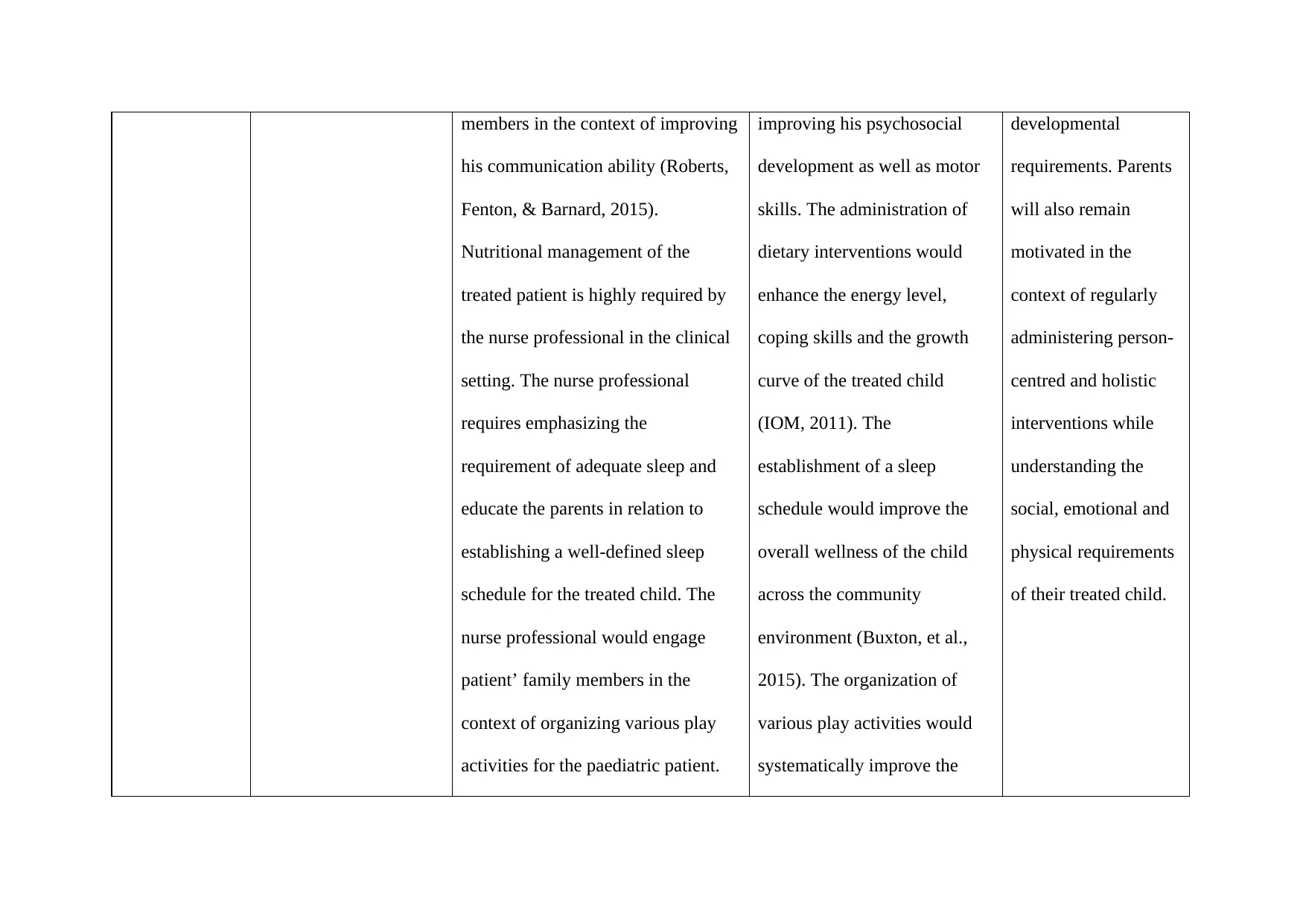
members in the context of improving
his communication ability (Roberts,
Fenton, & Barnard, 2015).
Nutritional management of the
treated patient is highly required by
the nurse professional in the clinical
setting. The nurse professional
requires emphasizing the
requirement of adequate sleep and
educate the parents in relation to
establishing a well-defined sleep
schedule for the treated child. The
nurse professional would engage
patient’ family members in the
context of organizing various play
activities for the paediatric patient.
improving his psychosocial
development as well as motor
skills. The administration of
dietary interventions would
enhance the energy level,
coping skills and the growth
curve of the treated child
(IOM, 2011). The
establishment of a sleep
schedule would improve the
overall wellness of the child
across the community
environment (Buxton, et al.,
2015). The organization of
various play activities would
systematically improve the
developmental
requirements. Parents
will also remain
motivated in the
context of regularly
administering person-
centred and holistic
interventions while
understanding the
social, emotional and
physical requirements
of their treated child.
his communication ability (Roberts,
Fenton, & Barnard, 2015).
Nutritional management of the
treated patient is highly required by
the nurse professional in the clinical
setting. The nurse professional
requires emphasizing the
requirement of adequate sleep and
educate the parents in relation to
establishing a well-defined sleep
schedule for the treated child. The
nurse professional would engage
patient’ family members in the
context of organizing various play
activities for the paediatric patient.
improving his psychosocial
development as well as motor
skills. The administration of
dietary interventions would
enhance the energy level,
coping skills and the growth
curve of the treated child
(IOM, 2011). The
establishment of a sleep
schedule would improve the
overall wellness of the child
across the community
environment (Buxton, et al.,
2015). The organization of
various play activities would
systematically improve the
developmental
requirements. Parents
will also remain
motivated in the
context of regularly
administering person-
centred and holistic
interventions while
understanding the
social, emotional and
physical requirements
of their treated child.
Paraphrase This Document
Need a fresh take? Get an instant paraphrase of this document with our AI Paraphraser
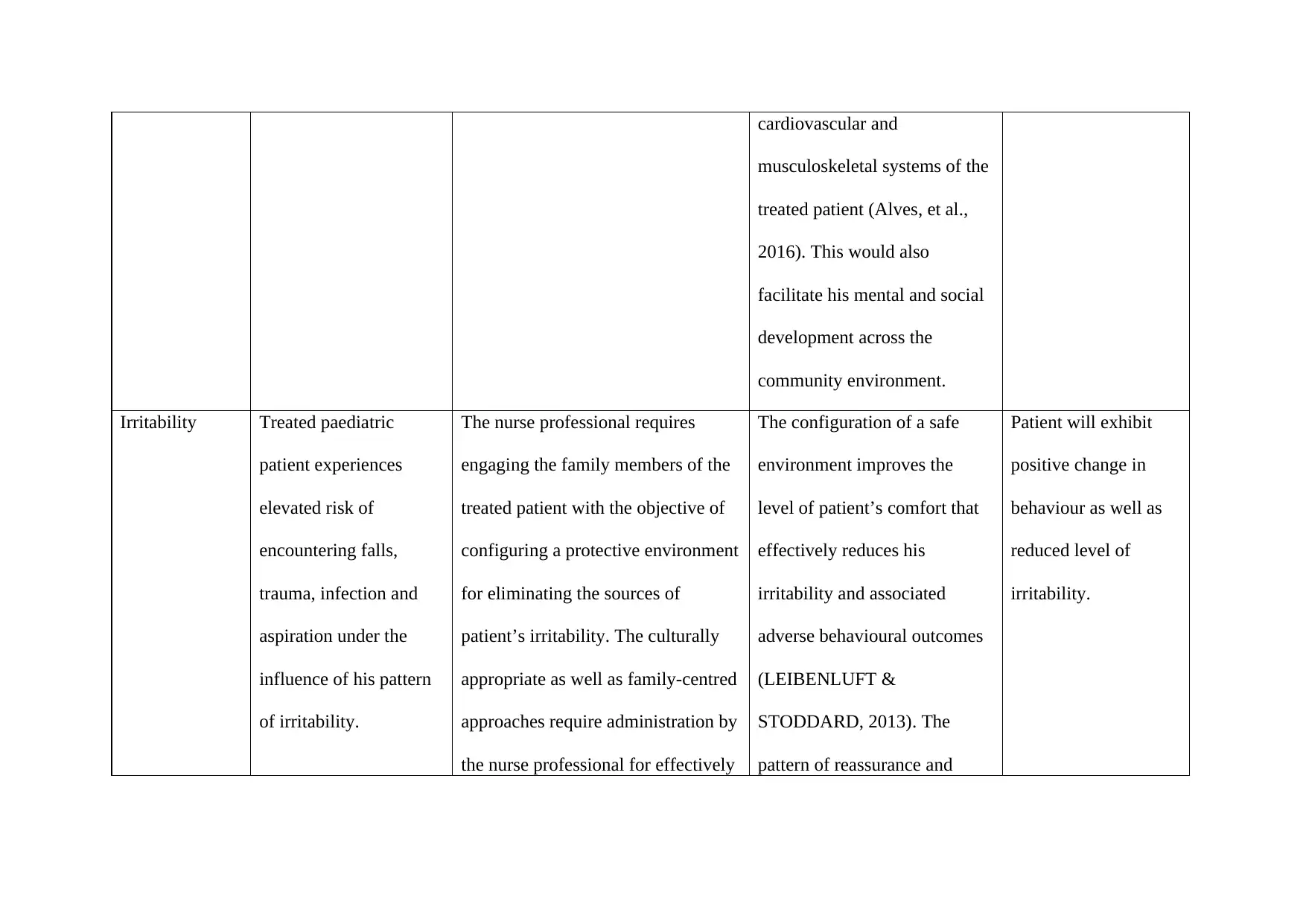
cardiovascular and
musculoskeletal systems of the
treated patient (Alves, et al.,
2016). This would also
facilitate his mental and social
development across the
community environment.
Irritability Treated paediatric
patient experiences
elevated risk of
encountering falls,
trauma, infection and
aspiration under the
influence of his pattern
of irritability.
The nurse professional requires
engaging the family members of the
treated patient with the objective of
configuring a protective environment
for eliminating the sources of
patient’s irritability. The culturally
appropriate as well as family-centred
approaches require administration by
the nurse professional for effectively
The configuration of a safe
environment improves the
level of patient’s comfort that
effectively reduces his
irritability and associated
adverse behavioural outcomes
(LEIBENLUFT &
STODDARD, 2013). The
pattern of reassurance and
Patient will exhibit
positive change in
behaviour as well as
reduced level of
irritability.
musculoskeletal systems of the
treated patient (Alves, et al.,
2016). This would also
facilitate his mental and social
development across the
community environment.
Irritability Treated paediatric
patient experiences
elevated risk of
encountering falls,
trauma, infection and
aspiration under the
influence of his pattern
of irritability.
The nurse professional requires
engaging the family members of the
treated patient with the objective of
configuring a protective environment
for eliminating the sources of
patient’s irritability. The culturally
appropriate as well as family-centred
approaches require administration by
the nurse professional for effectively
The configuration of a safe
environment improves the
level of patient’s comfort that
effectively reduces his
irritability and associated
adverse behavioural outcomes
(LEIBENLUFT &
STODDARD, 2013). The
pattern of reassurance and
Patient will exhibit
positive change in
behaviour as well as
reduced level of
irritability.
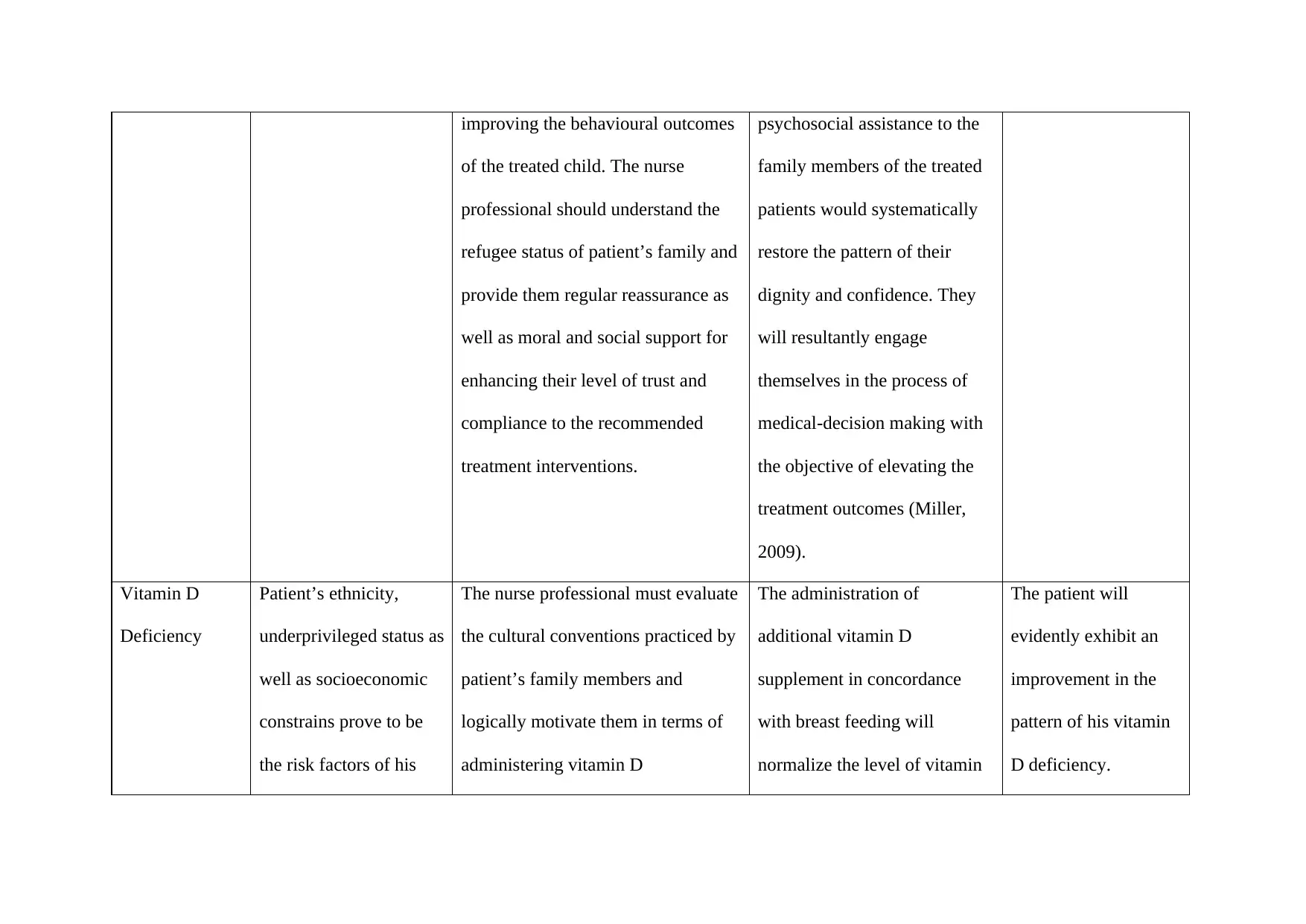
improving the behavioural outcomes
of the treated child. The nurse
professional should understand the
refugee status of patient’s family and
provide them regular reassurance as
well as moral and social support for
enhancing their level of trust and
compliance to the recommended
treatment interventions.
psychosocial assistance to the
family members of the treated
patients would systematically
restore the pattern of their
dignity and confidence. They
will resultantly engage
themselves in the process of
medical-decision making with
the objective of elevating the
treatment outcomes (Miller,
2009).
Vitamin D
Deficiency
Patient’s ethnicity,
underprivileged status as
well as socioeconomic
constrains prove to be
the risk factors of his
The nurse professional must evaluate
the cultural conventions practiced by
patient’s family members and
logically motivate them in terms of
administering vitamin D
The administration of
additional vitamin D
supplement in concordance
with breast feeding will
normalize the level of vitamin
The patient will
evidently exhibit an
improvement in the
pattern of his vitamin
D deficiency.
of the treated child. The nurse
professional should understand the
refugee status of patient’s family and
provide them regular reassurance as
well as moral and social support for
enhancing their level of trust and
compliance to the recommended
treatment interventions.
psychosocial assistance to the
family members of the treated
patients would systematically
restore the pattern of their
dignity and confidence. They
will resultantly engage
themselves in the process of
medical-decision making with
the objective of elevating the
treatment outcomes (Miller,
2009).
Vitamin D
Deficiency
Patient’s ethnicity,
underprivileged status as
well as socioeconomic
constrains prove to be
the risk factors of his
The nurse professional must evaluate
the cultural conventions practiced by
patient’s family members and
logically motivate them in terms of
administering vitamin D
The administration of
additional vitamin D
supplement in concordance
with breast feeding will
normalize the level of vitamin
The patient will
evidently exhibit an
improvement in the
pattern of his vitamin
D deficiency.
⊘ This is a preview!⊘
Do you want full access?
Subscribe today to unlock all pages.

Trusted by 1+ million students worldwide
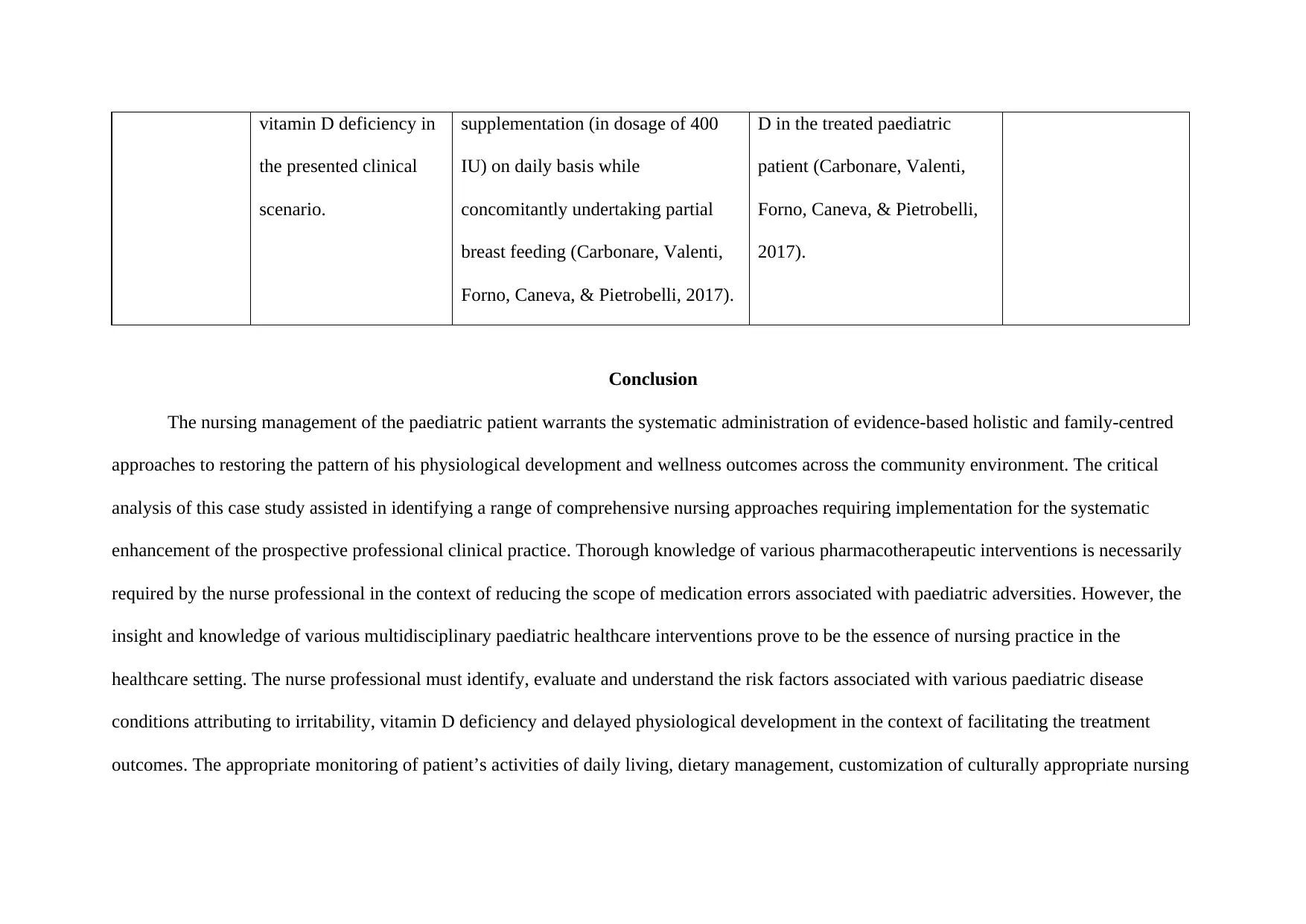
vitamin D deficiency in
the presented clinical
scenario.
supplementation (in dosage of 400
IU) on daily basis while
concomitantly undertaking partial
breast feeding (Carbonare, Valenti,
Forno, Caneva, & Pietrobelli, 2017).
D in the treated paediatric
patient (Carbonare, Valenti,
Forno, Caneva, & Pietrobelli,
2017).
Conclusion
The nursing management of the paediatric patient warrants the systematic administration of evidence-based holistic and family-centred
approaches to restoring the pattern of his physiological development and wellness outcomes across the community environment. The critical
analysis of this case study assisted in identifying a range of comprehensive nursing approaches requiring implementation for the systematic
enhancement of the prospective professional clinical practice. Thorough knowledge of various pharmacotherapeutic interventions is necessarily
required by the nurse professional in the context of reducing the scope of medication errors associated with paediatric adversities. However, the
insight and knowledge of various multidisciplinary paediatric healthcare interventions prove to be the essence of nursing practice in the
healthcare setting. The nurse professional must identify, evaluate and understand the risk factors associated with various paediatric disease
conditions attributing to irritability, vitamin D deficiency and delayed physiological development in the context of facilitating the treatment
outcomes. The appropriate monitoring of patient’s activities of daily living, dietary management, customization of culturally appropriate nursing
the presented clinical
scenario.
supplementation (in dosage of 400
IU) on daily basis while
concomitantly undertaking partial
breast feeding (Carbonare, Valenti,
Forno, Caneva, & Pietrobelli, 2017).
D in the treated paediatric
patient (Carbonare, Valenti,
Forno, Caneva, & Pietrobelli,
2017).
Conclusion
The nursing management of the paediatric patient warrants the systematic administration of evidence-based holistic and family-centred
approaches to restoring the pattern of his physiological development and wellness outcomes across the community environment. The critical
analysis of this case study assisted in identifying a range of comprehensive nursing approaches requiring implementation for the systematic
enhancement of the prospective professional clinical practice. Thorough knowledge of various pharmacotherapeutic interventions is necessarily
required by the nurse professional in the context of reducing the scope of medication errors associated with paediatric adversities. However, the
insight and knowledge of various multidisciplinary paediatric healthcare interventions prove to be the essence of nursing practice in the
healthcare setting. The nurse professional must identify, evaluate and understand the risk factors associated with various paediatric disease
conditions attributing to irritability, vitamin D deficiency and delayed physiological development in the context of facilitating the treatment
outcomes. The appropriate monitoring of patient’s activities of daily living, dietary management, customization of culturally appropriate nursing
Paraphrase This Document
Need a fresh take? Get an instant paraphrase of this document with our AI Paraphraser
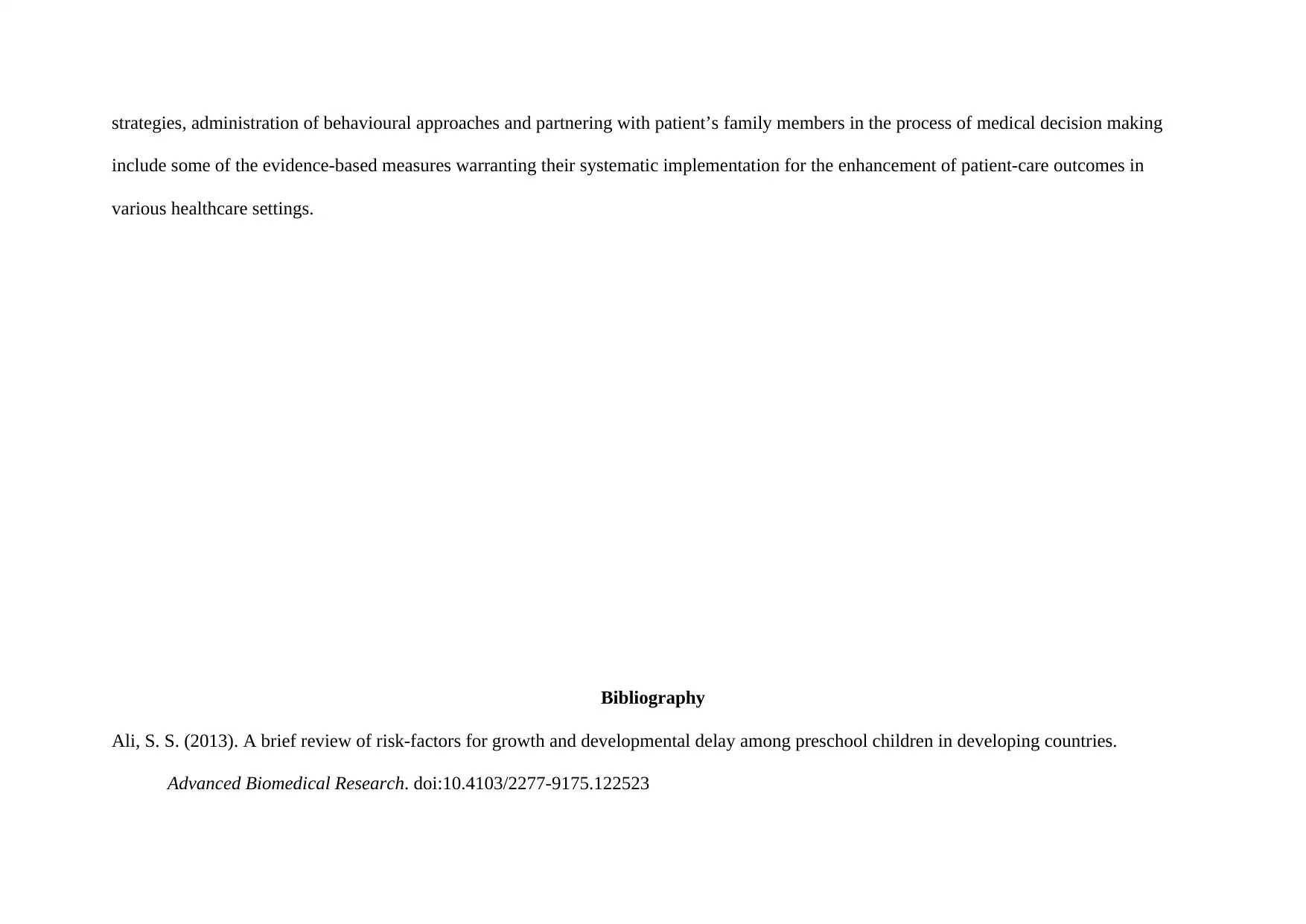
strategies, administration of behavioural approaches and partnering with patient’s family members in the process of medical decision making
include some of the evidence-based measures warranting their systematic implementation for the enhancement of patient-care outcomes in
various healthcare settings.
Bibliography
Ali, S. S. (2013). A brief review of risk-factors for growth and developmental delay among preschool children in developing countries.
Advanced Biomedical Research. doi:10.4103/2277-9175.122523
include some of the evidence-based measures warranting their systematic implementation for the enhancement of patient-care outcomes in
various healthcare settings.
Bibliography
Ali, S. S. (2013). A brief review of risk-factors for growth and developmental delay among preschool children in developing countries.
Advanced Biomedical Research. doi:10.4103/2277-9175.122523

Alves, A. J., Viana, J. L., Cavalcante, S. L., Oliveira, N. L., Duarte, J. A., Mota, J., . . . Ribeiro, F. (2016). Physical activity in primary and
secondary prevention of cardiovascular disease: Overview updated. World Journal of Cardiology, 8(10), 575-583.
doi:10.4330/wjc.v8.i10.575
Bhat, A. N., Galloway, J. C., & Landa, R. J. (2012). Relationship between early motor delay and later communication delay in infants at risk for
autism. Infant Behavior and Development, 35(4), 838-846. doi:10.1016/j.infbeh.2012.07.019
Buxton, O. M., Chang, A. M., Spilsbury, J. C., Bos, T., Emsellem, H., & Knutson, K. L. (2015). Sleep in the modern family: protective family
routines for child and adolescent sleep, 1(1), 15-27. Retrieved from https://www.ncbi.nlm.nih.gov/pmc/articles/PMC4712736/
Campbell, S. K., Gaebler-Spira, D., Zawacki, L., Clark, A., Boynewicz, K., deRegnier, R. A., . . . Zhou, X. J. (2012). Effects on Motor
Development of Kicking and Stepping Exercise in Preterm Infants with Periventricular Brain Injury: A Pilot Study. Journal of Pediatric
Rehabilitation Medicine, 5(1), 15-27. doi:10.3233/PRM-2011-0185
Carbonare, L. D., Valenti, M. T., Forno, F. d., Caneva, E., & Pietrobelli, A. (2017). Vitamin D: Daily vs. Monthly Use in Children and Elderly—
What Is Going On? Nutrients, 9(7), 652. doi:10.3390/nu9070652
Doyle, C. A. (2012). Pharmacologic treatments for the behavioral symptoms associated with autism spectrum disorders across the lifespan.
Dialogues in Clinical Neuroscience, 14(3), 263-279. Retrieved from https://www.ncbi.nlm.nih.gov/pmc/articles/PMC3513681/
secondary prevention of cardiovascular disease: Overview updated. World Journal of Cardiology, 8(10), 575-583.
doi:10.4330/wjc.v8.i10.575
Bhat, A. N., Galloway, J. C., & Landa, R. J. (2012). Relationship between early motor delay and later communication delay in infants at risk for
autism. Infant Behavior and Development, 35(4), 838-846. doi:10.1016/j.infbeh.2012.07.019
Buxton, O. M., Chang, A. M., Spilsbury, J. C., Bos, T., Emsellem, H., & Knutson, K. L. (2015). Sleep in the modern family: protective family
routines for child and adolescent sleep, 1(1), 15-27. Retrieved from https://www.ncbi.nlm.nih.gov/pmc/articles/PMC4712736/
Campbell, S. K., Gaebler-Spira, D., Zawacki, L., Clark, A., Boynewicz, K., deRegnier, R. A., . . . Zhou, X. J. (2012). Effects on Motor
Development of Kicking and Stepping Exercise in Preterm Infants with Periventricular Brain Injury: A Pilot Study. Journal of Pediatric
Rehabilitation Medicine, 5(1), 15-27. doi:10.3233/PRM-2011-0185
Carbonare, L. D., Valenti, M. T., Forno, F. d., Caneva, E., & Pietrobelli, A. (2017). Vitamin D: Daily vs. Monthly Use in Children and Elderly—
What Is Going On? Nutrients, 9(7), 652. doi:10.3390/nu9070652
Doyle, C. A. (2012). Pharmacologic treatments for the behavioral symptoms associated with autism spectrum disorders across the lifespan.
Dialogues in Clinical Neuroscience, 14(3), 263-279. Retrieved from https://www.ncbi.nlm.nih.gov/pmc/articles/PMC3513681/
⊘ This is a preview!⊘
Do you want full access?
Subscribe today to unlock all pages.

Trusted by 1+ million students worldwide
1 out of 15
Your All-in-One AI-Powered Toolkit for Academic Success.
+13062052269
info@desklib.com
Available 24*7 on WhatsApp / Email
![[object Object]](/_next/static/media/star-bottom.7253800d.svg)
Unlock your academic potential
Copyright © 2020–2025 A2Z Services. All Rights Reserved. Developed and managed by ZUCOL.
